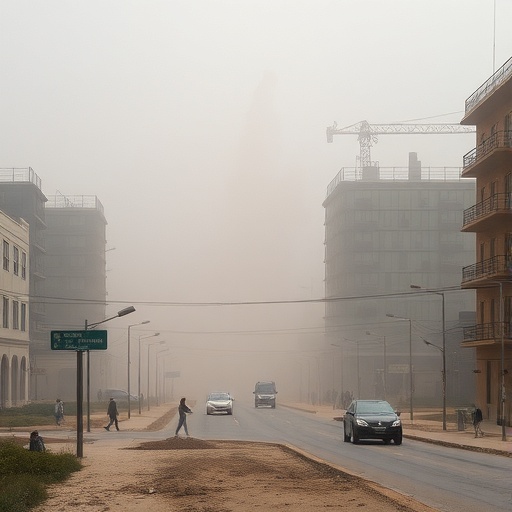Heavy metal contamination presents a severe environmental and public health concern in urban regions worldwide, particularly in developing countries where industrial growth and urbanization are rampant. In a recent study conducted in Bangladesh, researchers have uncovered alarming levels of heavy metals present in street dust, revealing not only the sources of this contamination but also the potential health risks it poses to the population. This extensive investigation, published in Environmental Monitoring and Assessment, draws attention to an issue that calls for urgent public health interventions and environmental policies.
Street dust, a common byproduct of urban life, serves as a significant repository for various pollutants, including heavy metals. The research led by M.H. Rahaman and colleagues sheds light on the sources of heavy metal contamination in urban areas, emphasizing the need for rigorous assessments to understand the scale and scope of the problem. By employing meticulous sampling and analysis techniques, the team gathered dust samples from various locations within the city, identifying critical hotspots that contribute to air and environmental pollution.
The study meticulously quantified heavy metals such as lead, cadmium, chromium, and arsenic among others. Notably, these metals are notorious for their toxicity and have been associated with numerous health issues ranging from neurological disorders to various forms of cancer. The accumulation of these metals in the environment and their subsequent inhalation or ingestion by urban dwellers can lead to serious long-term health consequences, particularly for vulnerable populations such as children and the elderly.
One of the most significant aspects of Rahaman et al.’s research is the identification of pollution sources through statistical and geographical analyses. The researchers linked high levels of heavy metals to several urban activities, including vehicular emissions, industrial discharges, and construction activities. The air quality in urban centers can be severely compromised by these activities, making the streets not just a transit area but a core site for contamination. This correlation underscores the urgent need for public policy reforms aimed at minimizing emissions and implementing stricter regulations on industrial discharges.
In evaluating the health risks associated with exposure to contaminated street dust, the research team employed commonly accepted assessment methodologies to estimate the potential exposure levels for the urban population. The findings indicate that regular exposure to contaminated dust can have deleterious health effects, leading to chronic diseases, and exacerbating existing health conditions. Particularly distressing is the evidence suggesting that young children may be disproportionately at risk, given their propensity to engage with their environment through hand-to-mouth activities.
The implications of this research extend far beyond mere statistics, calling for a multifaceted approach to tackle the issue of heavy metal contamination. Policymakers, urban planners, and public health officials must work collaboratively to establish comprehensive monitoring systems that can dynamically assess air quality and contamination levels in affected areas. Such systems would not only serve as an early warning mechanism but also promote community awareness regarding environmental health risks.
Moreover, public health campaigns aimed at educating residents about the potential hazards associated with untreated street dust can play a pivotal role in mitigating risk. Raising awareness about protective measures, such as regular handwashing, and using face masks during high pollution events, can significantly reduce individual exposure to harmful pollutants. Community engagement in sustainability practices, such as promoting green spaces and reducing single-use plastics, also contributes to diminishing pollution sources over time.
Furthermore, the study raises the issue of social equity in environmental health. Vulnerable communities, often with limited resources, are more likely to be situated near high-emission zones. Addressing this inequity is crucial to achieving broader public health goals and ensuring that all citizens have the right to a clean and safe environment. This can only be accomplished through the mobilization of local governments and non-governmental organizations to facilitate better living conditions for all residents.
Several countries have already begun implementing measures to combat heavy metal pollution and protect public health. The lessons learned from successful interventions in these regions can provide valuable insights for Bangladeshi authorities. For example, integrating urban green infrastructure, such as trees and vegetation, can help filter air pollutants and improve the quality of life in urban centers. Such strategies not only enhance environmental health but also offer recreational spaces that foster community well-being.
To support this endeavor, further research is essential to continuously monitor the sources and impacts of heavy metal contamination. Longitudinal studies that track changes over time could effectively inform policy decisions and public health strategies, ensuring that interventions are data-driven and responsive to emerging threats. The fight against heavy metal contamination is ongoing and requires the collective effort of scientists, policymakers, and community members alike.
Ultimately, the findings of this research serve as a wake-up call for urban dwellers and decision-makers to address the severe environmental challenges posed by heavy metals in street dust. As urbanization continues to rise globally, there is an imperative need for immediate action to safeguard public health and the environment. By embracing a proactive and informed approach, urban areas can transform from hotspots of pollution into models of sustainable living and health equity.
In conclusion, Rahaman et al.’s crucial work emphasizes the necessity of tackling heavy metal contamination in urban settings, particularly in rapidly developing regions like Bangladesh. The thorough examination of sources, health impacts, and mitigation strategies provides a critical framework for addressing this pressing issue. Moving forward, the imperative remains clear: we must prioritize environmental health to ensure that present and future generations can thrive in a clean, safe, and sustainable urban environment.
Subject of Research: Heavy metal contamination in street dust in urban Bangladesh
Article Title: Heavy metal contamination in street dust: source identification and health risk assessment in an urban Bangladeshi setting.
Article References:
Rahaman, M.H., Rahman, M.A., Khanam, R. et al. Heavy metal contamination in street dust: source identification and health risk assessment in an urban Bangladeshi setting.
Environ Monit Assess 197, 1135 (2025). https://doi.org/10.1007/s10661-025-14549-7
Image Credits: AI Generated
DOI: 10.1007/s10661-025-14549-7
Keywords: Urban health, heavy metals, environmental contamination, public policy, Bangladesh.




